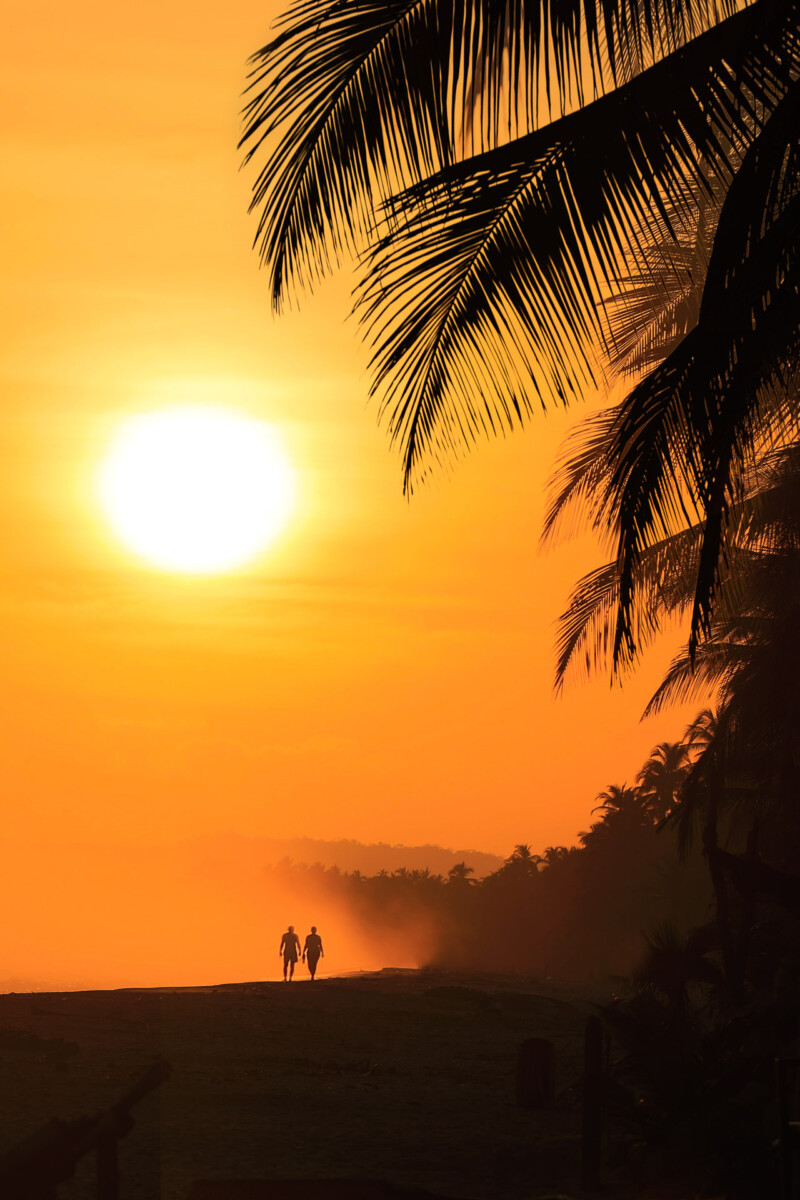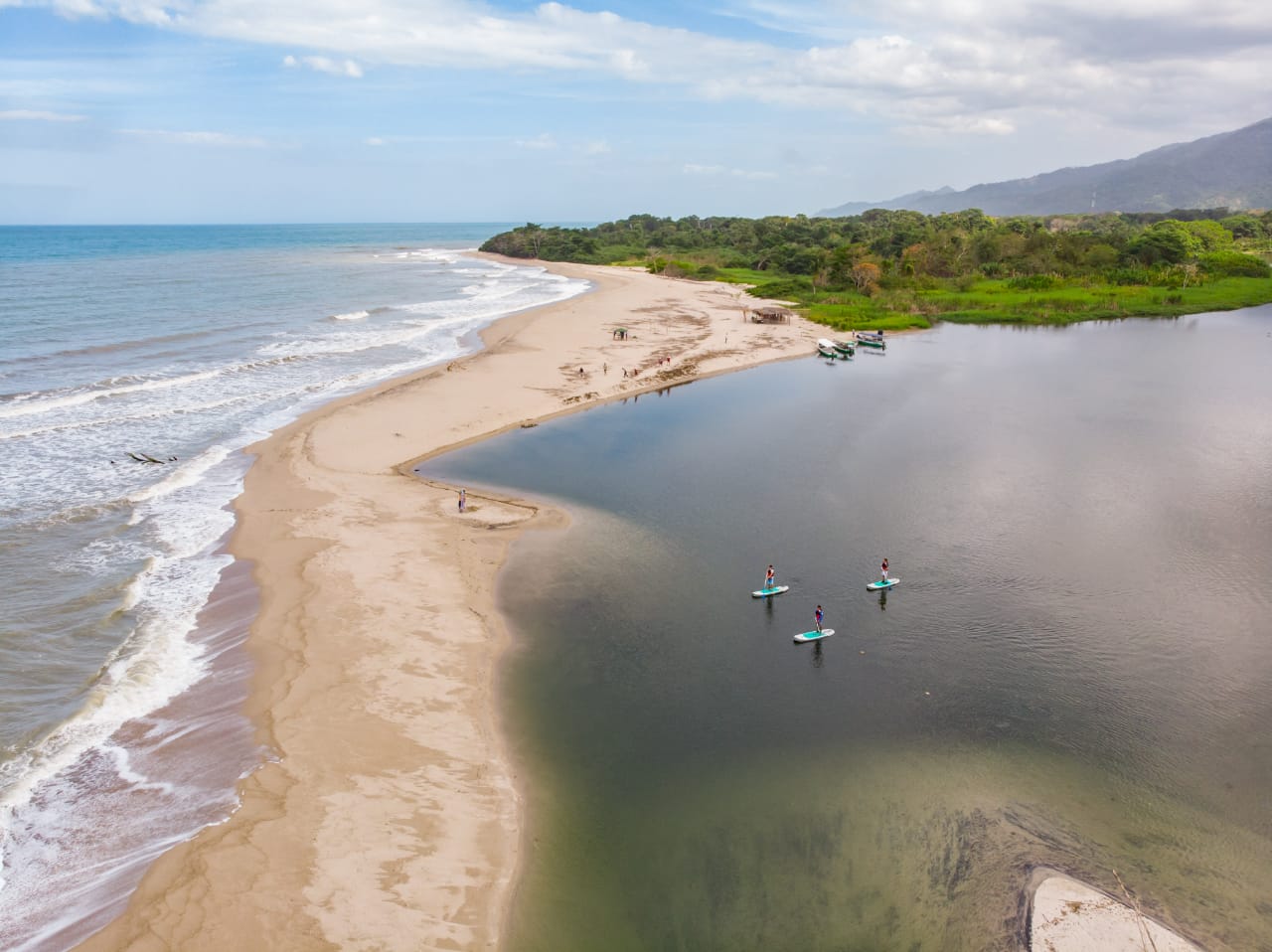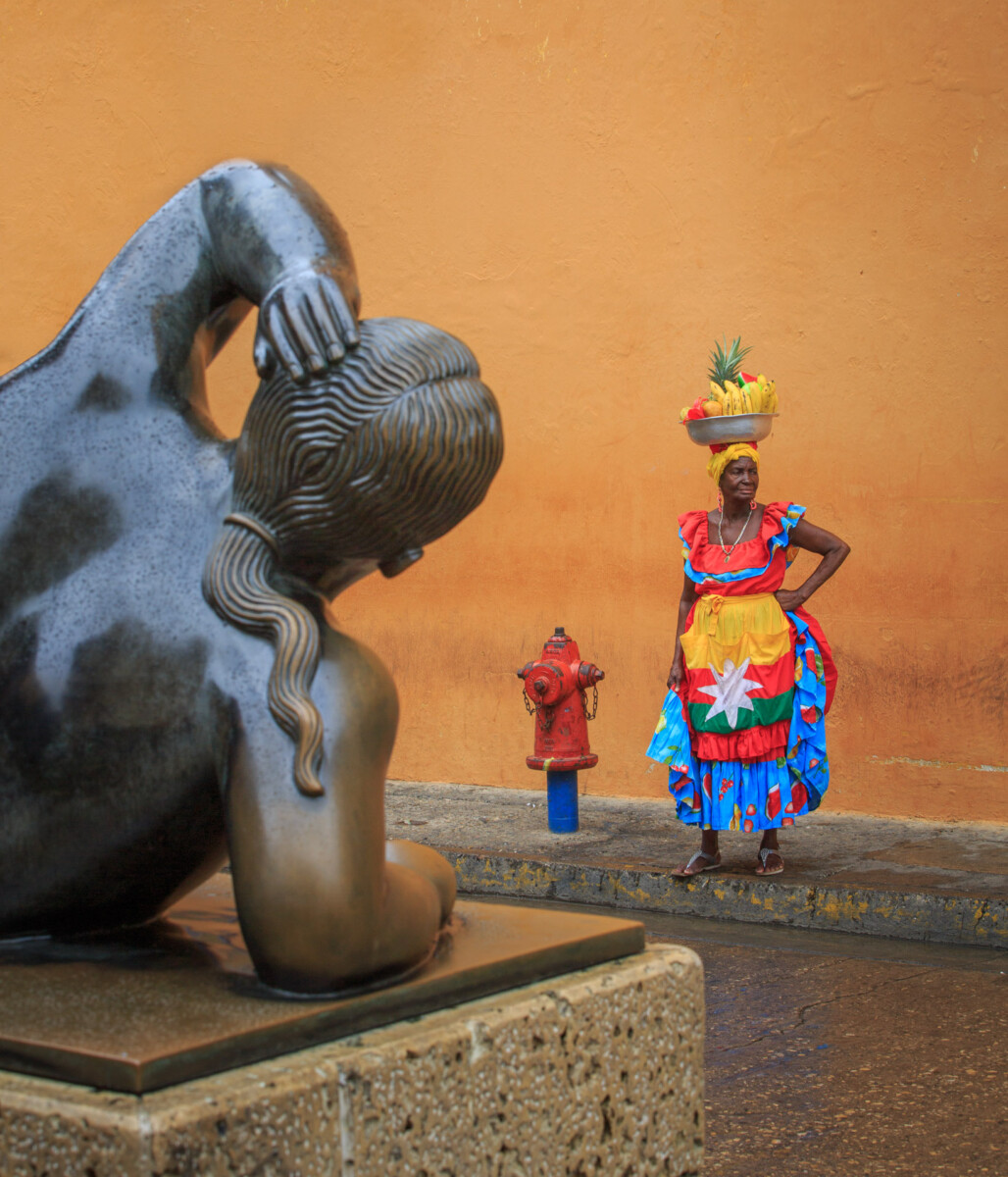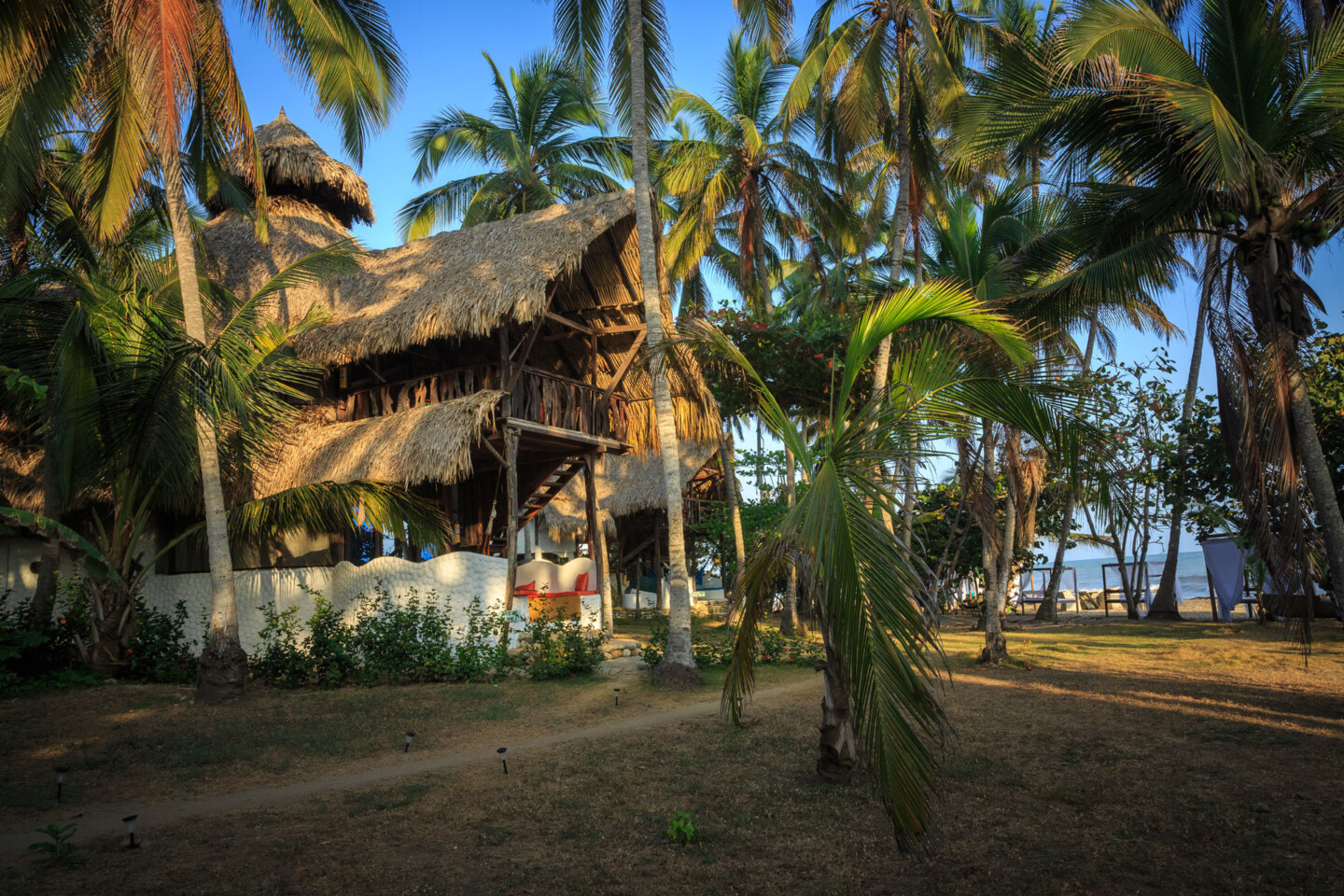Palomino Travel Guide
Explore Palomino: Logistics, sights, activities, accommodation, costs

Palomino in few words
Although the village has become very touristy in a short period of time, Palomino is a perfect place to take a break between Tayrona Park and the Guajira River.
Its Incredible Landscapes, one of the best places on the coast to observe the snowy peaks (Pico Colon and Pico Bolivar from the sea), its sunrises and its large expanses of deserted beaches.
Many people will boast about its beaches, but its real hidden treasure is the beauty of its river and mountains, which make it a must stop on your trip to the coast.

Palomino Essentials
- Best things to do in Palomino : Relaxing and Chilling, Tubing on Palomino River, Sunsets & Sunrises on the Beach, Trekking along the river, Surfing.
- Where to Stay in Palomino : Best luxury hotels in palomino are One Love, Best hotel close to the beach is Playa la Roca, and Best Packackers hostals are Dreamer Hostel & Tiki Hut.
- Where to Eat in Palomino : The Most Typical restaurants are along the main road “Troncal del Caribe”
How to get to Palomino : by bus from Santa Marta’s central Market (street 11th with 11). From Tayrona Park or Riohacha buses every 30min along the Troncal del Caribe. - Best time to Visit Palomino : Palomino can be visited all the year. Best time to see the snowy peaks of Sierra Nevada : January & February.
- High Season in Polomino : from December 15th to January 15th so more crowded and more expensive.
- Is Palomino Safe ? In short : Yes. People are friendly and there is almost no risk in Palomino.

Best things to Do in Palomino
Enjoy the Beaches of Palomino
The long, little frequented beach, bordered by its 2 rivers, its coconut palms, and in the background the jungle and the snowy summits have made the success of Palomino.
A perfect place to rest for a few days.
Take into account however that the sea is agitated and that it is difficult or even dangerous to swim there.
The advantage of Palomino is that you still have the option of swimming in the river.
If your priority is to swim on beaches with crystal-clear water, these items may be of interest to you:
Pro Tip : The biggest hotels in Palomino have swimming pools such as :

Tubing in Palomino
Tubing is THE ACTIVITY you should not miss during your stay at Palomino.
The activity consists of a short 40min hike in the jungle, then down the river on inner tubes.
The great advantage of this walk is that you will have a view of the magnificent fauna and flora from the “inside of the river”, while passing from the jungle to the Caribbean Sea, with the majestic snow-covered peaks of the Sierra Nevada peaking at 5775m in the background.

All the hotels in Palomino offer the tubbing tour, but you can get it at a more affordable price if you take the tour along the Troncal del Caribe.
Ask to take the tour with a local guide.
- Price : 40.000 Cop aprox
- Duration: 1 hour walking -2 hours tubing
- Walking level: Moderate
Pro Tips
- Remember to bring waterproof bags for your phone or camera.
- Many guides will tell you to “put on the sunscreen and go flip flop. Here we will tell you the opposite: it is better to leave with a good pair of shoes with a good grip, which can get wet.
- And rather than putting on sunscreen and mosquito repellent that pollute the river, prefer a hat and long sleeves.
- Remember that tourism as devastating consequences on nature. It is up to us to protect it!
Is tubing at Palomino dangerous?
Don’t worry, the river is not deep at all (1m or 2 max), and the current of the river is very calm. For safety reasons they also provide you with a life jacket, there is no risk.
Did you know that ?
Many films have been shot in the area, such as “The Mission”.
Visit the Seydukwa Community
Hidden among the jungle mountains of the Sierra Nevada de Santa is Seydukwa, a spiritual place for the Arhuaco Indians that inhabit the Palomino river basin.
Seydukwa is protected by the Mamos (indigenous authority), and reaching it is a privilege for lovers of nature and ancestral cultures.
If you dare to live this incredible experience that will allow you to get closer to the ancestral rites of the indigenous communities, and learn about environmental conservation from the perspective of this millennial community that considers the mountain the heart of the world.
The tour is totally unforgettable, you will have unique places that you will remember forever and you will enjoy the exuberant green jungle full of wildlife, in addition you will marvel at its snow-capped peaks and crystalline rivers.
This expedition can only be contracted with the same Arhuaco indigenous that live in Seydukwa, and you can live the experience in 1 day from $200,000 COP, in 2 days from $350,000 COP or in 3 days from $500,000 COP.

Surf in Palomino
If you do not know how to surf but you want to try it, Palomino is definitely the ideal place to take your first classes.
Palomino surf is usually calm, but keep in mind that this can be affected by the weather, so if you dare to tame your first waves, you should always be accompanied by an expert and consult which are the safest areas to do it.
Along the beach you can get surfboard rentals and surf schools that offer classes for beginners, the average prices are:
– Surfboard rental for one hour $20,000 COP
- Surf lessons in Palomino: $60,000 COP
You can find tables, bodyboards and surf lessons in Palomino at Chillandsurf, a small place next to Finca Escondida.
Boat tour to the sea (on Don Diego River)
The tour begins embarked on a boat with tents for 12 people which descends very smoothly by the waters of the Don Diego River, enjoying the fauna and flora of the region, in particular howler monkeys, local and migratory birds arrive at the mouth of the Don Diego River with the Caribbean Sea there will enjoy a time of 20 to 30 minutes of salt and fresh water can also take excellent pictures and at the end of the time return upstream to the starting point….

Cost per person:
- 1 a 2 $ 100.000
- 3 and up $ 40.000
Includes: Boat round trip, local guide. Duration: 1.30 h/m
Note: the boats are written to the Association of boatmen of the Don Diego River (Asoland).
Paddle on don diego river
The tour begins embarked on a boat to go up the Don Diego River to reach the farm the cacique enjoying the fauna and flora of the region, arrive at the right point to receive instructions from the local guide on the handling of the boards Paddle surf is to slide standing on the surfboard if you keep some balance with a paddle in hand can glide over the water very easily but could also kneeling, sitting and even lying enjoying the current of the river Don Diego, watching the howler monkeys, migratory birds
You can take a pleasant swim in the salt and fresh water until the boat arrives for the return trip to the starting point.

Cost per person
- 1 person 150.000
- 2 persons $120.000 per person
- 3 and upwards $ 100.000 per person
- Includes: Local guide, paddle surf boards, vest, bottle of water for each person, boat to go up to the cacique and back to the parking lot, variety of cacique and back to the parking lot, variety of fruits in the sea.
*Tour duration 3.30 minutes
Recommendations: sunscreen, insect repellent, comfortable clothes for swimming, sunglasses and bag for cell phone or camera.
Tubing tours to the sea on Don Diego River
The tour starts at our partner office with a 20 minute walk in the company of a local guide along the “Trail in the footsteps of the Tayronas” observing the fauna and flora of the region, the highest coastal peaks in Colombia Colon and Bolivar as well as the Sierra Nevada de Santa Marta. You will arrive at the point where the floats will be waiting with their respective vest.

There you will begin the descent in tubing through the refreshing waters and current of the Don Diego River descending from the Sierra Nevada de Santa Marta, in the descent you will have the opportunity to observe the sighting of Howler Monkeys, local and migratory birds, you will enjoy a natural spectacle until you reach the Union of the River with the Caribbean Sea here you will enjoy for 30 minutes of the fauna and flora and a wonderful place, at the end of the time a boat will be waiting for you to return upstream to the starting point (parking)
- Cost per person
- 1 a 2 $ 120.000
- 3 in advance $ 50.000
Includes: 1 local guide for every 6 clients, tubing down to the sea, boat return to the starting point.
- Duration of the tour 3 hours
Recommendations: Sun block lotion, insect repellent, a bottle of water, comfortable clothes for bathing.
Note: the activity is very safe, the guides are trained by SENA.
San Salvador River
Walking to the San Salvador River means reaching one of the most natural, lonely and least crowded places in Palomino.
To get to the San Salvador River you must walk at least 1 hour along the beach, a route where you can get closer to the “honeysuckle”, segments of fresh water that do not flow into the sea.
The walk starts on the main street of Palomino and is the same one that leads to the beach, then you arrive at Las Marías beach, and from there you walk eastwards along the beach until you reach the mouth.
Si vous avez de la chance, vous pourrez observez les magnifiques Pics enneigés Colon et Bolivar (Meilleure périodes pour observer les pics enneigés : Janvier & Février).
Taironaka Archeological Park
20 minutes by bus from Palomino you arrive at the Taironaka Archaeological Park, a natural reserve in the foothills of the Sierra Nevada de Santa Marta, where you can learn about archeology and ancient symbolism.
In Taironaka you will find restored terraces where the Indians built their homes and an archaeological museum with original pieces.

Also, in Taironaka you can find bird watching plans from $250,000 COP, where you will have the opportunity to see different species of toucans, parrots, hummingbirds and flycatchers.
If you plan to visit the Tayronaka Ecohotel Park, keep in mind that here you can book rooms from $150,000 COP, or here you can book a 3-day plan for two people with lodging, visits to the Arhuaca indigenous community, the Tayrona Museum, and ecological walks from $550,000 COP.
Quebrada Valencia Waterfall
The waterfall can be crowded, especially in high season (December 15 to January 15), especially since there are hotels such as the Mendihuaca that offer it as a Fare excursion.
The waterfall can be dry depending on the season, the best time to visit it with plenty of water is at the end of the rainy season (early December).
Nevertheless it is a nice walk to do. It takes 20-30min walk to get there. The path is very well indicated.
How to Get to Palomino ?
You can reach Palomino from Santa Marta, Tayrona or Riohacha.
How to get to Palomino from Santa Marta ?
Getting to Palomino from Santa Marta by bus
Go to the Mercado Público Calle 11 con Carrera 9, there you will find the big Green buses that go to Palomino and that pass Tayrona Park on the way.
- Bus Shedule : Departure every half hour from 06:00 to 5:00pm
- Duration of the trip : 2 hours
- Price : about $9,000 COP

Ask the driver to warn you when you arrive at Palomino.
Ideally you should get off at the gas station.
There are also buses that leave from the Santa Marta terminal in the direction of riohacha or Maicao. 15000 Cop Aprox
Getting to Palomino From Santa Marta Renting a car
If you want to take a road trip from Santa Marta, and have the freedom to visit Taganga, Minca, Palomino and Tayrona at your own pace, a good idea is to rent a car. Here you can compare the available offers and rent a car at the best price.
Getting to Palomino From Santa Marta Renting a Motorcycle
If you would like to visit the area in an adventurous style and go off path, another good idea is to rent a motorcycle. We partner with Adrian who runs Colombian Riders, a top rated motorbike Rental agency
Getting to Palomino from Cartagena by Bus
You can take a bus in the direction of Santa Marta and then follow another one in the direction of Palomino.
Door to Door Marsol: The Marsol Bus Company can pick you up at your hotel in the center and take you directly to Palomino.
- Price: 79.000 Cop
- Departure: 6am and 10am
- Duration: 7 hours
- Contact : (+57) 319 6919185
- Address :
In Cartagena you can also rent a car from $120,000 COP, to drive and stop in Santa Marta, Taganga and even visit the Los Flamencos Flora and Fauna Sanctuary.

How to Get to Palomino from Minca
Price : Minca to Palomino = 300.000 Cop
It is possible to leave by bus from Mamatoco. Colectivos that leave from Mamatoco to Riohacha for: 35000 Cop
Getting to Palomino from Tayrona Park
Buses leaving from the Santa Marta market pass every 30 minutes in front of the entrance of Tayrona Park. Wave to the driver.
- Price : 6000 Cop
Getting to Palomino from Riohacha
Buses leave from the riohacha terminal every 30 minutes.
- Price : 15000 Cop aprox.
How to get around in Palomino
If you arrive by bus, the driver will drop you off at the gas station.
From there, you can take a motorcycle cab for 3000 Cop or you can walk to your hotel.
Most of the hotels are located towards the sea, there is only a big dirt road, you can’t miss it.
Take into account that it takes 20 min to reach the beach of Palomino.
Where to Stay in Palomino?
In Palomino, most of the hotels are located in the village, towards the sea. If you have the budget, there are also excellent options at the entrance of Palomino (5 min by cab), or on the river side.
In Palomino you can stay in hammocks, hostels or in luxury hotels, depending on your budget.

The price of hammocks or shared rooms starts from 20.000 Cop per night.
Obviously, the closer the rooms are to the sea, the more expensive they are.
The environment in these lodges is very similar, some with a little more action and where you can find many backpackers, however some of the lodgings offer a little more privacy and tranquility, and all will connect you with nature.
If you are looking for the best prices, remember to look on the other side of the road, on the river side.
Among the best accommodations in Palomino are:
- Dreamer Hostel Palomino (www.thedreamerhostel.com)
- Primaluna Hostel
- Reserva One Love
- Makao
- Tiki Hut Hostel
- Palomino Hostel
- Bikini Hostel
What To pack for traveling to Palomino ?
A Palomino tries to take what is necessary, light suitcase is the best way to walk long distances and enjoy nature. However, do not forget to bring:
- Sunblock
- Swimsuit
- Lightweight waterproof Shoes with good grip (for the tubbing)
- Lightweight raincoat.
- Flip-flops for the beach
- Hat.
- Cash
Also, if you’re going camping, it’s a good idea to bring a torch for the night, toilet paper and a small kit with the basics.
Where to Eat in Palomino ?
You will have 3 kinds of restaurants: the typical restaurants and tourist restaurants that arrived a few years ago, and the catering services offered in the hotels.
The typical Colombian restaurants are located along the troncal del Caribe (main road). You can eat good fish with Patacon and Rice a la Coco, all at an affordable price.
As many foreigners have settled in Palomino, you will find an international gastronomic offer (Pizzas, Seafood, Caribbean Fusions, Vegetarian, etc…).
Is Palomino Safe ?
The crime rate in the villages is very low in Colombia because everyone knows each other.
Nevertheless, there is not much light in the small alleys in the evening, which can be scary.
But as long as you respect the basic principle: Don’t give Papaya, there will be no worries.
It is important to know the context and the past of Palomino: For a long time, the region was dominated by the paramilitaries who ruled the area.

As you know, these armed gangs were involved in drug trafficking, and often extorted the local landowners (Vacuna) claiming to ensure “their security” in exchange. Although this traffic has disappeared, it still exists.
In fact, the paramilitaries control all forms of petty crime because they solve the problem themselves.
More info: Safety in Colombia: Complete Guide
Budget for a trip to Palomino
- Bus from Santa Marta to Palomino: $15,000 COP
- Hostel in shared room : COP 25 000
- Two-day meal: $50,000 COP
- Palomino Tower Tubes: $40,000 COP
Where to go after Palomino ?
If you have arrived in Palomino, you have surely visited many sites on the road, so the most logical thing to do is to continue to the Guajira.
But if not, check out our comprehensive guides on the best things to visit in the area
- Travel to Guajira Complete Tourism Guide
- SFF Flamingos
- Rio Don Diego
- Tayrona Park Complete Travel Guide
- Lost City
- Travel to Minca : Complete Tourism Guide
- Taganga
- Travel to Mompox : Complete Tourism Guide
- Travel to Cartagena : Complete Tourism Guide
Also take into account that there is an airport in Riohacha that can connect you to bogota and the rest of the country.
Palomino Wiki
Palomino is in the department of La Guajira, Colombia.
It is a small village in the municipality of Dibulla, 5 hours from Cartagena, 2 hours from Santa Marta and 1 hour and a half from Riohacha.
Palomino is bathed by the river that carries the same name and the San Salvador River, in the first you can do tubing and from there you can see the highest mountain at sea level, but we’ll talk about that later.
The streets of Palomino are mostly unpaved and the dust rises easily with the passing of motorcycles, the most common means of transport you will find there.
Palomino is at 2 meters above sea level, has a humid tropical climate, and although its average temperature is 28ºC.
Before Palomino was not very visited by travelers but rather by anthropologists and scientists, but for some years it is the most popular beach for backpackers in the country, so you can find people of all nationalities and cultures.

A few years ago, was very frequented by anthropologists, and Koguis hippies.
But in less than 5 years, the village became the capital of the Backpackers of Colombia.
Victim of its success, many foreigners settled down: hotels and restaurants were pushed all along the path leading to the beach.
But in less than 5 years, the village became the capital of the Backpackers of Colombia.
Victim of its success, many foreigners settled down: hotels and restaurants grew like mushrooms all along the path leading to the beach.